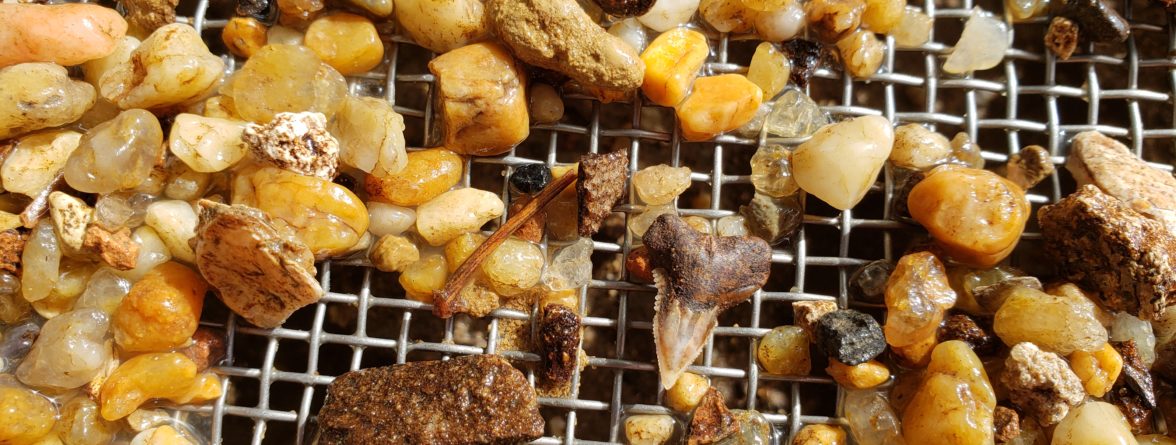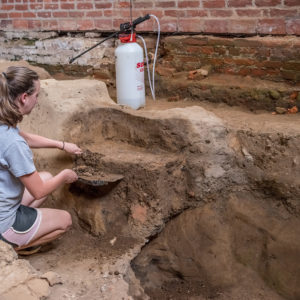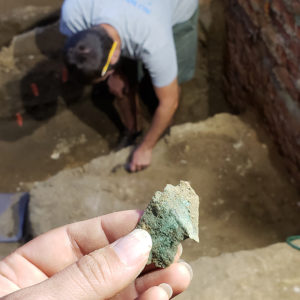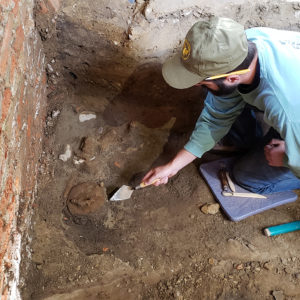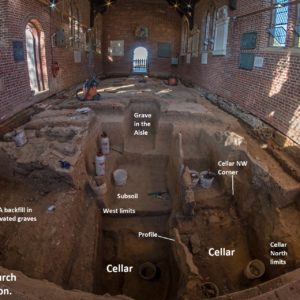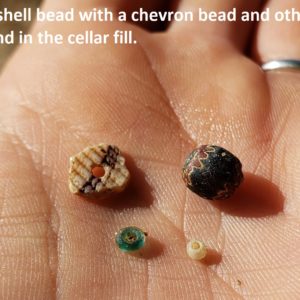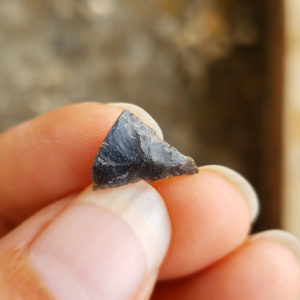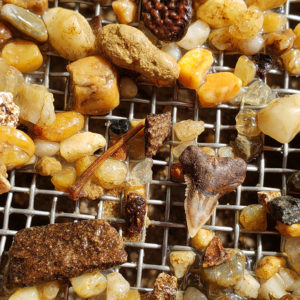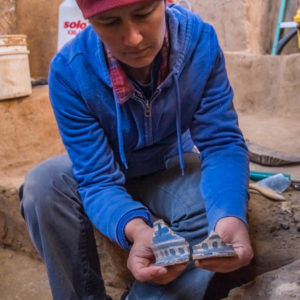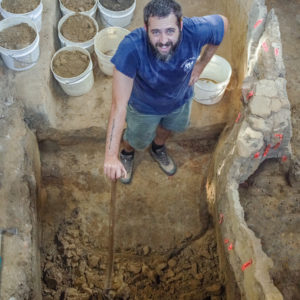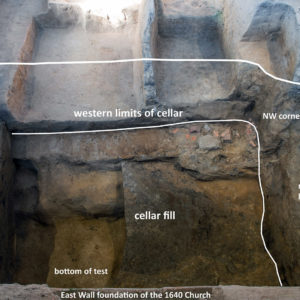As the excavations in the 1906 Memorial Church began to wind down, Jamestown Rediscovery archaeologists devoted the last couple of weeks to investigating a back-filled cellar found in the church’s eastern end. The feature is associated with a James Fort period structure that pre-dates the churches built on the site later. Similar to others found in the fort constructed around 1607-1608, the cellar’s location indicates that it was built contemporary with James Fort’s 1608 extension. As expected, excavations of the feature revealed an assemblage of artifacts dating prior to the 1617 construction of the first church in this location. In all, an undisturbed section approximately six by ten feet and four feet deep in the cellar’s northwest corner was excavated.
Adjacent to the brick foundation of the 1640s church, the cellar was first identified after removing backfill from early 20th-century excavations in the chancel. Intermittent excavation in the area subsequently led to the discovery of the cellar’s northern boundary. By September the border of the west side was defined. Although it was significantly impacted by multiple church constructions and a dozen burials, one thin section of a soil profile miraculously survived! Only two to five inches wide and seven feet long, the profile offered a glimpse of the different soil deposits below the top of the original ground surface.
The top layer contained large amounts of wall plaster from the 1640s deconstruction of the 1617 church. The plaster appeared to lay where it fell as the church was torn down. Much was mixed in a thick layer of orange clay that is believed to be part of the wall fabric of the 1617 church.
Most artifacts were recovered from a sand- and gravel-filled layer, similar to the densest fill layer in the blockhouse cellar, designated Structure 193. The fill in both appears to be from the same source—a path in the 1608 fort extension. In addition to copious amounts of river gravel, both contained Venetian beads, English and local tobacco pipe fragments, and numerous crushed ceramic sherds of earthenware, stoneware, and porcelain. Providing the terminus post quem for the church cellar layer, a porcelain sherd from Zhangzhou, China, is part of a dish recovered from pre-1617 fill in Structure 183, the second kitchen cellar.
Other artifacts in the gravel-rich layer include a copper alloy finger ring and several scrap copper fragments thought to relate to trade. An arrowhead made of English flint and a purple mussel shell bead may point to the Virginia Indians who lived in James Fort until the autumn of 1609. A number of iron objects were discovered, which x-rays may identify in the next couple of months. The faunal remains were numerous, and include domestic animals such as hogs and cattle, many wild species like deer and raccoon, and fish, notably gar and sturgeon. The team even found a couple of fossilized shark teeth that colonists likely collected from the local beaches as curiosities.
A layer of cleaner sand and clay lay below the artifact-rich layer. Except for a few brick chunks that appear to have fallen off a shelf carved along the western side, very few artifacts were encountered in this deeper layer. They include fire-cracked quartzite and a handful of Virginia Indian pottery sherds, both typically found in Jamestown’s Native horizon, and a sheep or goat mandible. A chunk of Bermuda limestone recovered from the layer provides a terminus post quem of May 1610.
The profile at this level indicated that the layer dipped downward under the east foundation of the 1640s church. Showing no sign of leveling or ending, an auger was used in an attempt to determine its depth. Not reaching the end, the auger easily bored the layer, suggesting that a well may lie beneath. If so, this is the third cellar with a well in it found in James Fort. For the teams’ safety and to prevent potential structural damage to the east wall of the 1640s church, excavations were halted. Hopeful that a portion of the cellar may extend outside the Memorial Church’s east wall, the Rediscovery team plans to investigate that area sometime in the next couple of years. Stay tuned as more exciting archaeological discoveries are made!
related images
- Kaitlyn Fitzgerald excavates the last of the APVA excavation backfill from the cellar’s northwest corner earlier this summer.
- A fragment of plaster wall related to the 1617 Church. This piece and many more like it were found in the top layer of the cellar.
- Copper scrap found in the cellar
- Bob Chartrand points to collection of various iron artifacts clustered together in one of the cellar’s trash layers
- Cellar in the church during excavation
- Visitors watch as Les Jennings and Anna Shackelford screen for artifacts in the soil coming out of the cellar
- A mussel shell bead, chevron bead, and other glass beads found in the cellar fill
- The tip of a projectile point fashioned from English flint
- A pig jaw found in the cellar
- Fish bones and a shark’s tooth found in the gravel layer
- Mary Anna Hartley holds the base to a large delft drug jar found in the cellar fill
- Trays of artifacts found in the cellar
- Bob Chartrand takes a break from filling buckets from a lower layer of the cellar
- Bob Chartrand uses an auger to help determine if the cellar has a well in it
- Features within the excavated cellar


